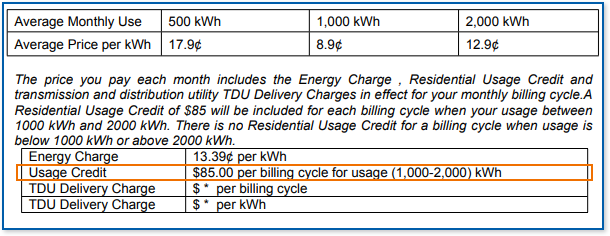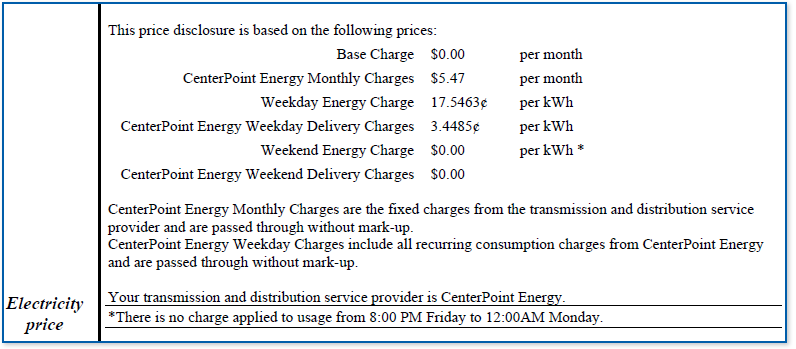We want to make sure you understand the various plan types to choose from before you purchase them so you can make sure the plan you select works for you. Let’s walk through the most common plan types you’ll encounter here in Texas.
Fixed Rate
With this type of contract, you lock in a single rate that does not change for the entire length of your contract. The only variables that can impact your monthly bill with this type of plan are how much electricity you use and a change in your TDU charges.
If you like stability and not being surprised by your electric bill, this could be the right plan for you.
How do you know if you are on a Fixed Rate Plan?
If you would like to check if your plan is a fixed rate, you can do so by looking at the “Disclosure Chart” section of the Electricity Facts Label (EFL) you received when you enrolled. Here you will find a subsection labeled “Type of Product” which will indicate the type of contract you have. See example of a Fixed Rate Plan EFL, below.

Example of Fixed Rate Plan - Electricity Price Box

Example of Fixed Rate Plan - Disclosure Chart
Indexed, Market, Wholesale or Changing Rate
A lot of different names to tell you the same thing: your electricity rate is tied to the wholesale electricity market, which means the rate you pay is constantly fluctuating. Some months you may pay less than those on fixed plans, but some months you may pay drastically more.
As you can imagine, this plan option is not for those who prefer a stable, predictable bill.
How do you know if you are on an Indexed, Market, Wholesale or Changing Rate Plan?
On your Electricity Facts Label (EFL), you can look for the terms “wholesale” or “index” in the Electricity Price section. See example of a Wholesale Plan EFL, below.

Example of Wholesale Plan
Variable or Tiered Plans
These should set off your consumer radar. Tiered plans often advertise low rates, but they come with a significant catch: your electricity usage must fall within a very specific usage window in order to achieve the rate advertised. If you don’t hit that window, your bill can be extraordinarily high. These type of plans are often deceptive to the common consumer, which has resulted in the Public Utility Commission of Texas removing them from the Power to Choose website's default search results.
How do you know if you are on a Variable or Tiered Plan?
On your Electricity Facts Label (EFL), you can look for terms such as “usage credit”, “threshold” or “usage <= x “. In the case of Tiered Plans it is common to see a fee listed on the line with “Usage Credit”. See example of a Tiered Rate Plan EFL, below.

Example of Tiered Electricity Plan
Plan Variants
Time-of-Use Plans
Often advertised as “Free Electricity” or “Free Weekends or Nights” plans, these plans generally charge a fixed rate during a part of the day or week, and then don’t charge you anything for your usage in the free periods (i.e. weekends or nights). Often, the fixed rate you pay during what the chargeable period is higher than that offered for non-time-of-use plans, but if you use more than 30% of your energy at night or on the weekends, these plans can result in savings.
How do you know if you are on a Time-of-Use Plan?
Time-of-use is a variant of a fixed price plan. You may be on this type of plan if you receive tips from your supplier about reducing your usage during certain periods in order to decrease your energy bill. On your Electricity Facts Label (EFL), you can look for the list of energy charges in the Electricity Price section. See example of a Time-Of-Use Plan EFL, below.

Example of Time-Of-Use Plan
Prepaid Plans
Instead of paying your electric bill once a month, you preload a certain amount of money into your account and pay for your electricity as you go. It works similarly to paying for a phone in advance. These plans are often a good fit for people that don’t find a long-term contract favorable, or for those who would like to avoid paying a deposit but are still working to improve their credit.
How do you know if you are on a Prepaid Plan?
If you are on a pre-paid plan, you probably know it. However, if you’re uncertain you can look on your Electricity Facts Label (EFL) in the Disclosure Chart section for the answer to the listed question “Is this a pre-pay or pay in advance product?”.

Example of Pre-Paid Plan